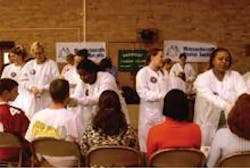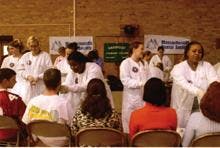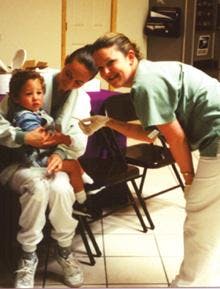CHIPS: CHILD IDENTIFICATION PROGRAM
by Laura Najjar, CDA
The evolution of dentistry has brought many changes over the years. I have been part of the profession for 28 years, serving as a Certified Dental Assistant, an office manager, a consultant, and now as an educator. When I entered dental assistant school many years ago, I never dreamed this field would reach the levels that it has today. Vast improvements in dental materials and mandatory regulations for sterilization are but a few of the innovations that have changed priorities dramatically in the dental office. Our profession has come a long way and we have learned so much from it. It's fair to assume that within the next 15 years the profession will be even more advanced than it is today.
Alarming statistics
As dentistry has changed, so has the world we live in. Children and teenagers today are at a greater risk of being abducted than ever before. In 1999, the U.S. Department of Justice National Incidence Studies reported that 354,100 children experienced family abductions. Approximately 3,200 to 4,600 were the victims of nonfamily abductions; many ended in death. Another 450,700 were runaways, while 127,100 children were "throw-aways." Another 139,100 children were lost, injured, or otherwise missing.
In 2001, the FBI National Crime Information Center reported 840,279 missing persons (adults and juveniles) in the United States. They estimate that 85 to 90 percent of missing persons are juveniles. This approximation averages to 2,000 per day.
National studies report that more than half of child abduction murders are committed by a stranger. The average age of an abductor is 27, and the majority of the abductors are unmarried and either live alone or live at home.
Better identification
In our fast-paced society, the need for child identification is imperative. CHIP (Child Identification Program), which is sponsored by the Freemasons, is an identification program that 20 states have successfully used for many years. When it was first implemented, CHIP consisted of fingerprinting along with an individual videotaped interview, which gave law enforcement officials more information than any other identification program.
In 1998, Dr. David B. Harte, a dentist and Mason from Milton, Mass., who currently is the Director of CHIP, connected The Missing Link to the program. He implemented Toothprints®, a bite impression device developed by Dr. David Tesini. This innovation made CHIP the most comprehensive identification program in the nation. The saliva on the Toothprint not only acts as a powerful "scent tracer" for FBI recovery dogs, but it also can provide a DNA sample. Children are now instructed to leave a "spit trail" if lost in the woods or mountains, which can lead to a fast and safe recovery by search and rescue canine recovery teams.
For years, positive identification was made through dental charts. Toothprints, like fingerprints, are unique yet durable, since teeth can withstand temperatures of up to 5000°F and can easily differentiate even identical twins. However, 70 percent of children today are filling-free. The advent of fluoridated water, dental sealants, and dental education often means a blank patient chart to follow. The Toothprint impression is so definitive that it even picks up the imprint of a dental sealant, something that many children have. Toothprints captures the size, shape, anatomy, restorations, and articulation of teeth, leaving nothing out.
The Freemasons, the Massachusetts Dental Society, and Massachusetts Crime Prevention Officers Association united in 1999 to collectively offer the most comprehensive child identification program in the world. CHIP is provided free of charge to the public, and all of the identifying items generated are given to the children's families. The program consists of the following components:
• Videotaping: The CHIP interview captures the appearance, speech, mannerisms, and other important personal characteristics of a child that a still photograph cannot. Questions can often lead to children's safe return, while a Smile Image can lead to positive identification.
• Fingerprinting: This as we know is a well known means of identification and is even more important for investigative purposes. No two fingerprints are alike.
• Toothprints®: The bite impression is quick and easy to fabricate. The imprint gives accurate information for identification purposes showing tooth site, architecture, and bite relation, which is an invaluable tool.
Abductions are on the rise, and there is an urgent need to protect our children from this frightening statistic. It is essential that we as a nation join together to involve children in this program to make our world a safer and happier place to live. I urge all of you to visit the CHIP Web site and start making a difference in your community. For more information, visit www.mychip.org, or call (800) 882-1020 x 214.
This article originally appeared in the March/April 2003 issue of The Dental Assistant and is reprinted with permission. References available upon request.


